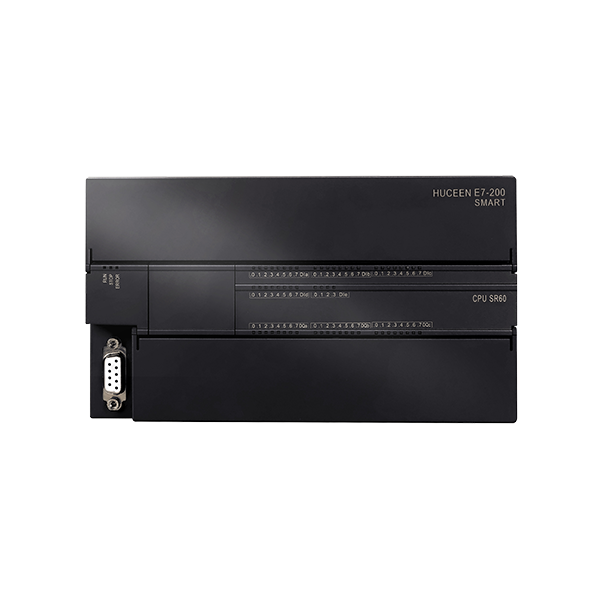Description
E7 200Smart CPU Standard Edition,CPU SR60 Relay,36DI/24DO,1*RJ45,2*RS485, Expandable to 6IO
General Overview
- Model Number: SR60 AC/DC/RLY
- Article Number: E7 288-1SR60-0AA1
- Description: Standard CPU SR60 with relay outputs, suitable for both AC/DC control applications.
- Dimensions (WxHxD): 175 mm × 100 mm × 81 mm
- Power Consumption: 25W
Electrical Specifications
- Available Current:
- SM Bus: Max. 1400mA
- 24V DC: Max. 300mA
- Input Voltage: 85V – 264V DC (AC compatible)
- Input Current (CPU only):
- 130mA at 120V AC (without 300mA power supply for sensors)
- 250mA at 120V AC (with 300mA power supply for sensors)
- 80mA at 240V AC (without 300mA power supply for sensors)
- 150mA at 240V AC (with 300mA power supply for sensors)
- Input Current (Includes CPU + Expansion Modules):
- 130mA at 120V AC
- 190mA at 240V AC
- Inrush Current (Max): 16.3A at 264V DC
- Sensor Voltage: 20.4V – 28.8V DC
- Isolation:
- Input to Logic: 1500VAC (lasting 1 minute)
- Sensor to Logic: Not isolated
Memory and Data
- Program Memory: 30 KB
- Data Memory: 20 KB
- Retentive Memory: 10 KB (permanent data preservation)
- Bit Memory (M): 256 bits
- Cycle Interrupts: 2 (T32 and T96) with a 1ms resolution
- Counters: 256
- Timers:
- Non-retained: 192 (TON, TOF)
- Retained: 64
I/O Specifications
- Built-in I/O:
- Digital Inputs: 36 (Sinking/Sourcing type, IEC type 1 sinking)
- Digital Outputs: 24 (Relay, dry contact)
- Analog I/O:
- Process Image Size: 256-bit input (I), 256-bit output (Q)
- Analog Input: 56 words (AI)
- Analog Output: 56 words (AQ)
I/O Characteristics
Digital Inputs:
- Allowable Continuous Voltage: Max. 30V DC
- Surge Voltage (Max): 35V DC (lasting 0.5s)
- Logic 1 Signal (Min): 15V DC with 2.5mA current
- Logic 0 Signal (Max): 5V DC with 1mA current
- Optical Isolation: 500V AC (lasting 1 minute)
- Filter Time: Configurable per channel (ranging from 0.2 µs to 12.8 ms)
Digital Outputs (Relay, Dry Contact):
- Voltage Range: 5V – 30V DC or 5V – 250V AC
- Surge Current (Max): 7A when power is turned on
- Rated Current per Point (Max): 2.0A
- Switching Frequency: Not recommended for high-frequency switching
- Turn-on Delay (Qa.0-Qa.3): Up to 10ms
- Turn-off Delay (Qa.4-Qc.7): Up to 10ms
- Optical Isolation: 500V AC (lasting 1 minute)
- Contact Lifetime:
- Non-loaded: 10 million cycles
- Rated Load: 10,000 cycles
Expansion and Counters
- Expansion Modules Allowed: Up to 6 modules
- High-Speed Counters: 6 in total, with specific frequencies:
- Single Phase: 4 counters at 200kHz + 2 counters at 30kHz
- Quadrature Phase: 2 counters at 100kHz + 2 counters at 20kHz
- Pulse Output: Not available
Communications and Ports
- Ethernet:
- 1 Ethernet port with 10/100 Mb/s data rate
- CPU Communication (PUT/GET): 8 clients and 8 servers connections
- Open Type Communication: 8 active and 8 passive connections
- RS485:
- 2 DB9-RS485 ports
- 1 DB board serial port (CM01-RS485-RS232)
- RS485 Free Port: Supports 1200 to 115200 b/s data transmission rates
- HMI Connections:
- 8 connections via Ethernet
- 4 connections via serial port
- Programming (PG) Connection: 1 connection
Performance and Processing Time
- Boolean Operations: 0.35 µs per instruction
- Moving Word Operations: 1.2 µs per instruction
- Floating Point Operations: 1.7 µs per instruction
